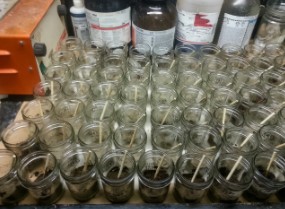By Kaine Korzekwa
After an oil spill or leak, it’s important to act fast. If the oil has gotten into soil, scientists need to rapidly assess how much oil there is and how far it spread. It’s a process that has always been costly and time-consuming.
Nuwan Wijewardane at University of Nebraska-Lincoln knew there had to be a better way. He and his team found a new method using state-of-the-art technology that is faster and cheaper. It lets scientists get to work quicker on restoring the soil.

These laboratory-constructed soil samples contain various concentrations of petroleum hydrocarbons.
“Accidental releases of oil at production and distribution sites can pose serious environmental issues if not treated,” explains Wijewardane. “This demands remedial actions to assist in the rapid restoration of the ecosystem to its pre-contamination state. It is critical to be able to estimate concentration levels in impacted soil quickly and easily.”
The traditional methods for analyzing these soils are done in the laboratory and involve multiple steps. It requires collecting samples from the spill site and then taking them off-site for analysis. These increase the cost, time, and labor of the project.
“It costs about $50 per sample,” says Wijewardane. “And that does not include the cost of the labor needed to collect samples from the field. In addition, it can take days or maybe weeks to get results.”
The research team thought they could accomplish two things. One was using a faster and cheaper technology called Vis-NIR spectroscopy. The other was finding a way to measure the oil content in soil without having to take the time to gather so many samples from the spill site.
Click here to see more...